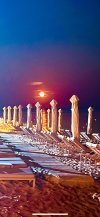Managed to get a ferry Newhaven to Dieppe and see that in northern France, sat outside a cafe in a square in a small town few miles from Dieppe, was very eerie.
Next one is 8th April 2024 crossing USA
Nearer home one crossing northern Spain, and western Iceland 12th August 2026
For the 1999 eclipse I was in Berkshire, near Hungerford, at the time. Very similar day to today basically: a uniform layer of mid-level cloud but no rain.
It was noticeably gloomy for August, but not dark or even twilight-ish: it went from being like midday on a cloudy August day to being like 3pm on a cloudy November or December afternoon, if you get my drift.
The angle of the ecliptic is the critical factor. When the angle of the ecliptic is near to horizontal than Mercury isn't far above the horizon even when it is a long way from the sun. When the angle of the ecliptic is near to vertical Mercury will be much higher in the sky and thus easier to see.
Very true. You can see that now, as the Moon, Venus and Sun form a near-vertical line. The same phenomenon presumably also explains why appearances of Venus in the spring are much more prominent than at other times of year. At the moment, for example, Venus is a long way from the sun and sets long after.
Venus appears to have an 8-year cycle (see edit below). So Venus would also have been prominent in the springs of 2015, 2007, 1999, 1991, 1983, etc.
I do seem to remember 2007 had a spring appearance of Venus, I distinctly remember it emerging from the evening twilight in early January and being visible until the middle of July. I think I vaguely remember the 1991 appearance too.
I also seem to remember a prominent spring appearance in 2009, but a bit earlier in the year, so it was already prominent, but low, in the previous November, and peaked in March. Also remember a 1989 appearance (as I first started getting interested in 1989), but that was later in the year, first appearing around May and peaking in the summer/autumn.
So with an 8-year cycle, this gives appearances at intervals a little over 18 months:
Summer/autumn X+1 (e.g. 1989)
Spring X+3 (e.g. 2023, 2007, 1991)
Winter/early spring X+5 (e.g. 2009)
[presumably there's a fourth one, and maybe even a fifth one, but I can't remember any instances. Presumably it's very low in the sky and not prominent]
where X is a year in the sequence 1980, 1988, 1996, 2004, 2012, etc.
Also seems to indicate that evening appearances of Venus are focused on odd years.
EDIT: I've just checked
https://www.fourmilab.ch/yoursky, which gives historical maps of the sky. I put in this date in 1975, and every year on an 8-year cycle until 2015. Venus was in
almost exactly the same position in Gemini each year. So it looks like the 8-year cycle is indeed present.
I've also verified the existence of the "1989" (X+1) and "2009" (X+5) evening apparations too, again these occur on an 8-year cycle. So following this appearance of Venus, we can presumably expect one in winter/spring 2025.



